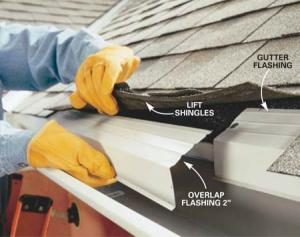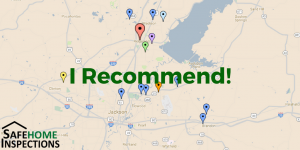Hello Gary –
Our home doesn’t have a gutter system. We sit on a hill and have not had drainage problems or issues with water collection after heavy rains.
However, similarly situated homes in our neighborhood seem to have a gutter system. How do I know whether or not I need to install a gutter system?
Thanks, Fran
Hi Fran – Several factors can come into play. Without gutters, your home’s windows, doors and siding will be coated when it rains. That can increase the opportunity for leaks. A gutter can help control water volume and can help prevent leaks.
Overhang
How wide is your roof overhang (how far does the roof overhang the siding/brick)?  Wide overhangs will protect your home’s exterior wall better than a short overhang or no overhang at all.
Wide overhangs will protect your home’s exterior wall better than a short overhang or no overhang at all.
In our local area (Metro Jackson, MS) the typical overhang is about 12″. Without gutters, water cascading over the roof’s edge can wash down the side of your home, especially in a windy rain event.
Windows, doors and siding will be coated with rain water and that can increase the opportunity for leaks. A gutter can help control the volume of water. Water control can help prevent leaks.
Think about where you’ll put gutter downspouts. You may not like where the gutter contractor installs them. Talk to your contractor first.
List of Considerations
Here are 4 points to think about if you are considering adding gutters.
Clogged Gutters. Do you have trees close? The gutters could require maintenance and that can add to your list of annual chores. Use a gutter guard if you need to keep leaves and debris from collecting and clogging up the system. Clogged gutters can prematurely rust aluminum gutters.
Gutter Extensions. If you decide to install gutters I recommend you add gutter extensions to the downspout. An extension will allow the water to terminate away from your foundation. DO NOT ALLOW WATER TO PUDDLE NEAR YOUR FOUNDATION
Eave Flashing. Does your home have eave flashing (see photo at right)? Without flashing you could have bare wood exposed at the edge of your root. Water and debris passing through the gutters could potentially rot the edge of your roof.
In Ground Water. Some folks send water from the gutter down spout into an in-ground pipe. Unless you are forced to do this, I don’t recommend it. Try to maintain surface drainage around your home. Surface drainage (water flowing on top of the ground) is easier to maintain.
Drainage After You Gutter
 You mention that you live on a hill. That’s great!
You mention that you live on a hill. That’s great!
Maintain positive drainage by not allowing water to puddle near the foundation. The proper slope (angle of our lawn) should be at least 5%. That means your lawn should slope away from your foundation and be 5 inches lower, 10 feet away from your foundation.
I Recommend
Like all home components proper installation is important. One of your home ownership goals is sustainability. A properly installed gutter coupled with proper maintenance can extend the life cycle of your home’s exterior and keep it looking like new.
Go here to find a gutter contractor I recommend.
- - - - - - - - - - - - - - - - - - - - -
One thought on “How Can I Tell If I Need Gutters?”